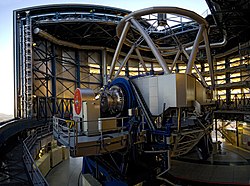Very Large Telescope
The Very Large Telescope (VLT) is a telescope operated by the European Southern Observatory. It is on Cerro Paranal in the Atacama Desert of northern Chile.
| Coordinates | Lua error in Module:Coordinates at line 614: attempt to index field 'wikibase' (a nil value). |
|---|---|
| Altitude | P2044 |
| Wavelength | 300 nm – 20 μm (visible, near- and mid-infrared) |
| Diameter | 4 x 8.2-metre Unit Telescopes (UT) 4 x 1.8-metre moveable Auxiliary Telescopes (AT) |
| Secondary diameter | P2386 |
| Tertiary diameter | P2386 |
| Illuminated diameter | P2386 |
| Length | P2043 |
| Width | P2049 |
| Mass | P2067 |
| Collecting area | P2046 |
| Illuminated area | P2046 |
| Focal length | P2151 |
| Website | {{URL|example.com|optional display text}} |
| Template:Wikidata location map | |
Overview
The VLT consists of four separate telescopes, each with a main mirror 8.2 metres across. They are often used separately, but they can be used together to get a very high angular resolution.[1] The observatory also has four movable Auxiliary Telescopes (ATs) of 1.8 m aperture.
It operates at visible and infrared wavelengths. Each individual telescope can detect objects roughly four billion times fainter than can be seen with the naked eye. When all the telescopes are combined, the facility can achieve an angular resolution of about 0.001 arc-second. This is equivalent to roughly two metres at the distance of the Moon.[1]
The VLT is the most productive ground-based facility for astronomy: only the Hubble Space Telescope leads to more scientific papers in observational astronomy.[2]
Among the pioneering observations carried out using the VLT are the first direct image of an exoplanet, the tracking of individual stars moving around the supermassive black hole at the centre of the Milky Way, and observations of the afterglow of the furthest known gamma-ray burst.[3]
Auxiliary Telescopes
The four smaller 1.8-metre ATs are available and dedicated to interferometry. This allows the VLT to operate every night on visible and infrared wavelengths.[3]
Very Large Telescope Media
The SPHERE instrument attached to the VLT Unit Telescope 3
The interior of Antu (UT1), meaning "sun" in the Mapuche language
Auxiliary Telescope, the Residencia and the heart of the Milky Way
All four 8.2-metre Unit Telescopes and 1.8-metre Auxiliary Telescopes were connected for the first time on 17 March 2011, becoming the VLT Interferometer (VLTI) with six baselines.
Related pages
References
- ↑ 1.0 1.1 "The Very Large Telescope". ESO. Retrieved 2011-08-05.
- ↑ Trimble V. & Ceja J.A. (2010). "Productivity and impact of astronomical facilities: a recent sample". Astronomische Nachrichten. 331 (3): 338–345. Bibcode:2010AN....331..338T. doi:10.1002/asna.200911339. S2CID 54516166.
- ↑ 3.0 3.1 "The Very Large Telescope — the world's most advanced visible-light astronomical observatory handout". ESO. Retrieved 2011-08-05.










